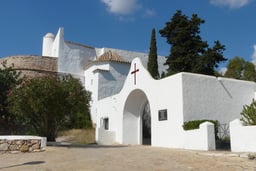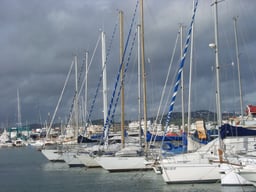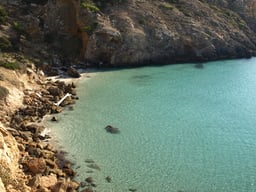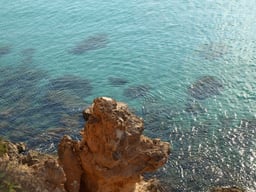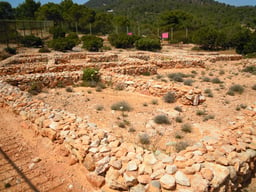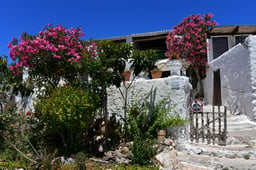Ibiza
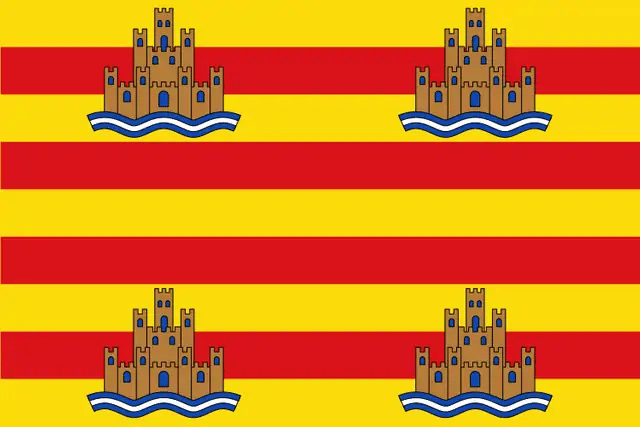
Ibiza

| Native name: | |
|---|---|
| Geography | |
| Location | Balearic Sea |
| Coordinates | |
| Archipelago | Balearic Islands,Pityusic Islands |
| Area | 571.6 km (220.7 sq mi) |
| Highest elevation | 475 m (1,558 ft) |
| Highest point | Sa Talaia |
| Administration | |
| Autonomous Community | Balearic Islands |
| Province | Balearic Islands |
| Capital city | Ibiza Town |
| Largest settlement | Ibiza Town(pop. 49,768) |
| Demographics | |
| Population | 143,856 (1 January 2017) |
| Pop. density | 251.2 /km (650.6 /sq mi) |
| Additional information | |
| Official languages:Catalan,SpanishIbiza Insular Council Emblem | |
| Official name | Ibiza, Biodiversity and Culture |
| Type | Mixed |
| Criteria | ii, iii, iv, ix, x |
| Designated | 1999(23rdsession) |
| Reference no. | 417[4] |
| State Party | Spain |
| Region | Southern Europe |
Ibiza (Spanish: [iˈβiθa]; Catalan: Eivissa [əjˈvisə]; see below) is a Spanish island in the Mediterranean Sea off the eastern coast of Spain. It is 150 kilometres (93 miles) from the city of Valencia. It is the third largest of the Balearic Islands, an autonomous community of Spain. Its largest settlements are Ibiza Town (Catalan: Vila d'Eivissa, or simply Vila), Santa Eulària des Riu, and Sant Antoni de Portmany. Its highest point, called Sa Talaiassa (or Sa Talaia), is 475 metres (1,558 feet) above sea level.
Ibiza has become well known for its association with nightlife, electronic dance music, and for the summer club scene, all of which attract large numbers of tourists drawn to that type of holiday. Several years before 2010, the island's government and the Spanish Tourist Office had been working to promote more family-oriented tourism, with the police closing down clubs that played music at late night hours, but by 2010 this policy was reversed.[2] Around 2015 it was resumed.[3]
Ibiza is a UNESCO World Heritage Site.[4] Ibiza and the nearby island of Formentera to its south are called the Pine Islands, or "Pityuses".
| Native name: | |
|---|---|
| Geography | |
| Location | Balearic Sea |
| Coordinates | |
| Archipelago | Balearic Islands,Pityusic Islands |
| Area | 571.6 km (220.7 sq mi) |
| Highest elevation | 475 m (1,558 ft) |
| Highest point | Sa Talaia |
| Administration | |
| Autonomous Community | Balearic Islands |
| Province | Balearic Islands |
| Capital city | Ibiza Town |
| Largest settlement | Ibiza Town(pop. 49,768) |
| Demographics | |
| Population | 143,856 (1 January 2017) |
| Pop. density | 251.2 /km (650.6 /sq mi) |
| Additional information | |
| Official languages:Catalan,SpanishIbiza Insular Council Emblem | |
| Official name | Ibiza, Biodiversity and Culture |
| Type | Mixed |
| Criteria | ii, iii, iv, ix, x |
| Designated | 1999(23rdsession) |
| Reference no. | 417[4] |
| State Party | Spain |
| Region | Southern Europe |
Names
The official Catalan name is Eivissa (locally [əjˈvisə]). Its name in Spanish is Ibiza (pronounced [iˈβiθa]). In British English, the name is usually pronounced in an approximation of the Spanish (/aɪˈbiːθə, ɪˈ-/ eye-BEE-thə, ih-[5]), whereas in American English the pronunciation is closer to Latin American Spanish (/ɪˈbiːzə/ ib-EE-zə,[6]ee-BEE-sə[7]]] [9] and so forth).
In the 18th and 19th centuries the island was known to the British and especially to the Royal Navy as Ivica.[14]
History

Ancient Greek aryballoi found in the necropolis of Puig des Molins. Museu de Puig des Molins, Ibiza
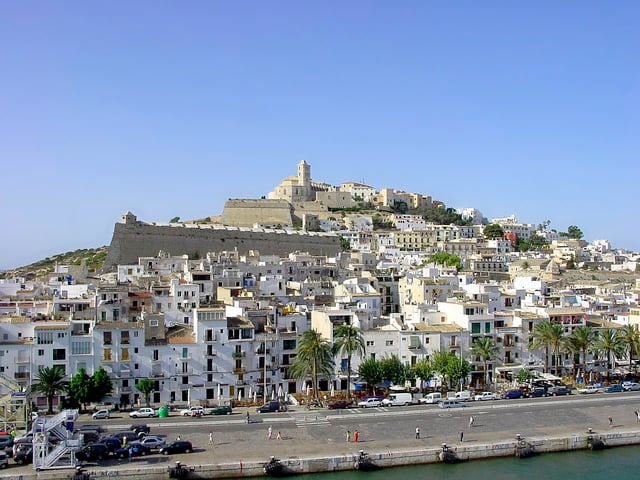
View of the old town from the port
In 654 BC, Phoenician settlers founded a port on Ibiza. With the decline of Phoenicia after the Assyrian invasions, Ibiza came under the control of Carthage, also a former Phoenician colony. The island produced dye, salt, fish sauce (garum), and wool.
A shrine with offerings to the goddess Tanit was established in the cave at Es Cuieram, and the rest of the Balearic Islands entered Eivissa's commercial orbit after 400 BC. Ibiza was a major trading post along the Mediterranean routes. Ibiza began establishing its own trading stations along the nearby Balearic island of Majorca, such as Na Guardis, and "Na Galera" where numerous Balearic mercenaries hired on, no doubt as slingers,[1] to fight for Carthage.
During the Second Punic War, the island was assaulted by the two Scipio brothers in 217 BC but remained loyal to Carthage. With the Carthaginian military failing on the Iberian mainland, Ibiza was last used, 205 B.C, by the fleeing Carthaginian General Mago to gather supplies and men before sailing to Menorca and then to Liguria. Ibiza negotiated a favorable treaty (Foedus) with the Romans, which spared Ibiza from further destruction and allowed it to continue its Carthaginian-Punic institutions, traditions and even coinage well into the Empire days, when it became an official Roman municipality.
After the fall of the Western Roman Empire and a brief period of first Vandal and then Byzantine rule, the island was conquered by the Moors in 902, the few remaining locals converted to Islam and Berber settlers came in. Under Islamic rule, Ibiza (Yabisah) came in close contact with the city of Dénia—the closest port in the nearby Iberian peninsula, located in the Valencian Community—and the two areas were administered jointly by the Taifa of Dénia during some time (11th century).
Ibiza together with the islands of Formentera and Menorca were invaded by the Norwegian King Sigurd I of Norway in the spring of 1110 on his crusade to Jerusalem. The king had previously conquered the cities of Sintra, Lisbon, and Alcácer do Sal and given them over to Christian rulers, in an effort to weaken the Muslim grip on the Iberian peninsula. King Sigurd continued to Sicily where he visited King Roger II of Sicily.[16]
The island was conquered by Aragonese King James I in 1235. The local Muslim population got deported as was the case with neighboring Majorca and elsewhere, and Christians arrived from Girona. The island maintained its own self-government in several forms until 1715, when King Philip V of Spain abolished the local government's autonomy. The arrival of democracy in the late 1970s led to the Statute of Autonomy of the Balearic Islands. Today, the island is part of the Balearic Autonomous Community, along with Majorca, Menorca, and Formentera.
World Heritage Site
Though primarily known for its party scene, large portions of the island are registered as UNESCO World Heritage Sites,[17] and thus protected from the development and commercialization of the main cities.
A notable example includes the Renaissance walls of the old town of Ibiza City which were awarded UNESCO World Heritage Status in 1999, they are one of the few world's Renaissance walls that were not demolished, and part of the medieval wall is still visible.
At "God's Finger" in the Benirràs Bay there are some of the more traditional Ibizan cultural sites such as the remains of the first Phoenician settlement at Sa Caleta. Other sites are still under threat from the developers, such as Ses Feixes Wetlands,[18] but this site has now been recognised as a threatened environment, and it is expected that steps will be taken to preserve this wetland.
Geography
Ibiza is a rock island covering an area of 572.56 square kilometres (221.07 sq mi), almost six times smaller than Majorca, but over five times larger than Mykonos (in the Greek Isles) or 10 times larger than Manhattan in New York City.
Ibiza is the larger of a group of the western Balearic archipelago called the "Pitiusas" or "Pine Islands" composed of itself and Formentera.
The Balearic island chain includes over 50 islands, many of which are uninhabited.
The highest point of the island is Sa Talaiassa, also known as Sa Talaia or Sa Talaia de Sant Josep at 475 metres (1,558 ft).
Administration
Ibiza is administratively part of the autonomous community of the Balearic Islands, whose capital is Palma, on the island of Majorca. Ibiza comprises 5 of the community's 67 municipalities. Clockwise from the south coast, these are:
Sant Josep de sa Talaia (Spanish: San José)
Sant Antoni de Portmany (San Antonio Abad)
Sant Joan de Labritja (San Juan Bautista)
Santa Eulària des Riu (Santa Eulalia del Río)
Vila d'Eivissa ("Ibiza Town"; known simply as Vila, "Town")
| Municipality | Area in square km | Census population 1 November 2001 | Census population 1 November 2011 | Estimated population 1 January 2017 |
|---|---|---|---|---|
| Sant Josep de sa Talaia | 159.4 | 14,267 | 24,079 | 26,133 |
| Sant Antoni de Portmany | 126.8 | 15,081 | 21,915 | 25,290 |
| Sant Joan de Labritja | 121.7 | 4,094 | 5,351 | 6,139 |
| Santa Eulària des Riu | 153.6 | 19,808 | 33,699 | 36,605 |
| Vila d'Eivissa(Ibiza) | 11.1 | 34,826 | 48,550 | 49,689 |
| Totals | 572.6 | 88,076 | 133,594 | 143,856 |
At the 2001 census these municipalities had a total population of 88,076 inhabitants, which had risen to an estimated 143,856 by the start of 2017, and have a land area of 572.56 km2 (221.07 sq mi).
Climate
Ibiza has a Hot-summer Mediterranean climate (Köppen: Csa) bordering on a Hot semi-arid climate (BSh). The average annual temperature of Ibiza is 18.3 °C (65 °F), being warm and mild throughout the whole year. Ibiza lies at the same latitude as Atlantic City, yet it is much warmer for its location in the Mediterranean Basin. The climate of Ibiza is typically warm, sunny and dry, with low variation between highs and lows. The sunshine hours of Ibiza are 2700-2800 per year, while the yearly rain amount goes from 400 to 450 millimetres (16 to 18 in). The average high temperature is 22.2 °C (72 °F), while the average low is 14.3 °C (58 °F). Winters are slightly rainy and mild, from November to April normally the whole island turns green for the seasonal rains. Summers are hot and very dry, with few rainy days, often accompanied by thunderstorms. During the coldest month, January, the average high temperature is 15.7 °C (60 °F), while the average low is 8.1 °C (47 °F). In the warmest month, August, the average high temperature is 30.3 °C (87 °F), while the low is 22.2 °C (72 °F). Extreme temperatures are rare for the influence of the sea. The average temperature of the sea in Ibiza is 19.7 °C (67 °F) and beach weather usually lasts 7 months, from May to November.[19]
| Climate data for Eivissa Airport 6 metres (20 feet) (1981–2010) | |||||||||||||
|---|---|---|---|---|---|---|---|---|---|---|---|---|---|
| Month | Jan | Feb | Mar | Apr | May | Jun | Jul | Aug | Sep | Oct | Nov | Dec | Year |
| Record high °C (°F) | 23.8(74.8) | 23.5(74.3) | 26.5(79.7) | 27.8(82.0) | 31.0(87.8) | 36.5(97.7) | 36.6(97.9) | 36.6(97.9) | 38.4(101.1) | 32.0(89.6) | 28.4(83.1) | 23.8(74.8) | 38.4(101.1) |
| Average high °C (°F) | 15.7(60.3) | 15.9(60.6) | 17.7(63.9) | 19.7(67.5) | 22.7(72.9) | 26.8(80.2) | 29.7(85.5) | 30.3(86.5) | 27.7(81.9) | 24.0(75.2) | 19.6(67.3) | 16.7(62.1) | 22.2(72.0) |
| Daily mean °C (°F) | 11.9(53.4) | 12.1(53.8) | 13.7(56.7) | 15.6(60.1) | 18.6(65.5) | 22.6(72.7) | 25.6(78.1) | 26.3(79.3) | 23.8(74.8) | 20.2(68.4) | 15.9(60.6) | 13.1(55.6) | 18.3(64.9) |
| Average low °C (°F) | 8.1(46.6) | 8.3(46.9) | 9.6(49.3) | 11.4(52.5) | 14.6(58.3) | 18.4(65.1) | 21.4(70.5) | 22.2(72.0) | 19.9(67.8) | 16.5(61.7) | 12.3(54.1) | 9.5(49.1) | 14.3(57.7) |
| Record low °C (°F) | −1.2(29.8) | 0.2(32.4) | 1.0(33.8) | 3.4(38.1) | 7.6(45.7) | 10.0(50.0) | 15.9(60.6) | 16.5(61.7) | 12.1(53.8) | 8.5(47.3) | 2.4(36.3) | 1.1(34.0) | −1.2(29.8) |
| Averageprecipitationmm (inches) | 37(1.5) | 36(1.4) | 27(1.1) | 31(1.2) | 27(1.1) | 11(0.4) | 5(0.2) | 18(0.7) | 57(2.2) | 58(2.3) | 53(2.1) | 52(2.0) | 413(16.3) |
| Average precipitation days(≥ 1 mm) | 5 | 5 | 3 | 4 | 3 | 1 | 1 | 2 | 4 | 6 | 6 | 5 | 45 |
| Average snowy days | 0.1 | 0.0 | 0.0 | 0.0 | 0.0 | 0.0 | 0.0 | 0.0 | 0.0 | 0.0 | 0.0 | 0.0 | 0.1 |
| Mean monthlysunshine hours | 162 | 166 | 211 | 246 | 272 | 299 | 334 | 305 | 236 | 205 | 157 | 151 | 2,744 |
| Percentpossible sunshine | 52 | 54 | 57 | 63 | 63 | 67 | 72 | 70 | 66 | 60 | 52 | 54 | 61 |
| Source #1:Agencia Estatal de Meteorología[20] | |||||||||||||
| Source #2:Agencia Estatal de Meteorología,[21] | |||||||||||||
Culture
The typical folkloric dance of Ibiza is Ball Pagès. The origin of these dances is unknown. Nowadays, this tradition is in the process of recovery, thanks to the efforts of different Colles of Ball Pages of the islands. The clothing of the dancers is very colorful. The speed of the dance can be slow, medium or fast, although Sa Llarga, is the most danced way, and it's fast, dynamic and energetic, where the male dancer jumps around the woman and lifts up his legs.
People
Demographically, Ibiza displays a very peculiar configuration, as census agencies diverge on exact figures.
According to the 2001 national census, Ibiza had 88,076 inhabitants (against 76,000 in 1991, 64,000 in 1981, 45,000 in 1971, and 38,000 in 1961).
However, by the 2011 national census, this had grown to 133,594, and by the start of 2017 had reached 143,856.
This rapid growth stems from the amnesty which incorporated a number of unregistered foreign migrants.
In terms of origin, about 55 percent of island residents were born in Ibiza, 35 percent are domestic migrants from mainland Spain (mostly working-class families from Andalusia, and the remainder from Catalonia, Valencia and Castile), and the remaining 10 to 15 percent are foreign, dual and multi-national citizens of the EU and abroad (Govern de les Illes Balears – IBAE 1996).
In decreasing order, the most commonly visiting foreigners are German, British, Latin American, French, Italian and Dutch, in addition to a myriad of other nationalities. This mosaic reflects the fluidity of foreigners living and moving across the island, in ways that render impossible to exactly quantify the expatriate population (Rozenberg 1990).
The Spanish composer and music theorist Miguel Roig-Francolí was born in Ibiza,[24] as was the politician and Spain's former Minister of Foreign Affairs, Abel Matutes.[25] Notable former residents of Ibiza include: English punk musician John Simon Ritchie (Sid Vicious),[26] the psychedelic rock band Philiac, comic actor Terry-Thomas,[27] Hungarian master forger Elmyr de Hory,[28] American author Clifford Irving, and film director/actor Orson Welles.[29]
Language
Eivissenc is the native dialect of Catalan that is spoken on Ibiza and nearby Formentera. Catalan shares co-official status with Spanish. Additionally, because of the influence of tourism and expatriates living in or maintaining residences on the island, other languages like English, French, German and Italian are widely spoken.[30]
Tourism
Nightlife

Sant Antoni, West End

Sunset at Café del Mar, Sant Antoni de Portmany
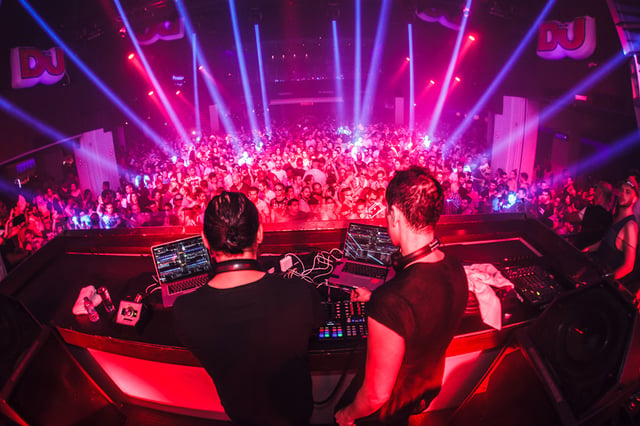
The discotheques of Ibiza are internationally renowned
Ibiza is considered to be a popular tourist destination, especially due to its well-known and at times riotous nightclub-based nightlife centred on two areas: Ibiza Town, the island's capital on the southern shore and Sant Antoni to the West.
Night life in Ibiza has undergone several changes since the island's opening to international tourism in the late 1950s.
Origins of today's club culture may be traced back to the hippie gatherings held during the 1960s and 1970s.
During these, people of various nationalities sharing the hippie ethos would regroup, talk, play music and occasionally take drugs.
These would most often happen on beaches during the day, with nude bathing a common sight, and in rented fincas in the evenings or at nights.
Apart from this confidential scene, which nevertheless attracted many foreigners to the island, local venues during the 1960s consisted mostly of bars, which would be the meeting points for Ibicencos, ex-pats, seafarers and tourists alike.
The Estrella bar on the port and La Tierra in the old city of Eivissa were favourites.[31]
During the 1970s, a decade that saw the emergence of the contemporary nightclub, several places opened and made a lasting impact on Ibiza's nightlife.
Four of these original clubs are still in operation today: Pacha, Privilege (formerly Ku), Amnesia and Es Paradís. These four clubs mainly defined nightlife on the White Island, which has evolved and developed from several distinctive elements: open-air parties (Es Paradis, Privilege, Amnesia), held in isolated places, eventually old fincas (Pacha, Amnesia), that mixed in nudity and costume party (Es Paradis, Privilege, Pacha) and enabled people from various backgrounds to blend (all). The hippie ethos served as a common factor that infused all these venues and catalyzed the experience of a certain kind of freedom, accentuated by the holiday nature of most of the stays on the White Island.
During the 1980s, the music played in these clubs gained in reputation and became known as Balearic beat, a precursor of the British acid house scene. As rave parties blossomed all over Europe, a DJ-driven club culture took hold of Ibizenca nightlife. It was at that time that Space opened, thanks to Pepe Rosello, which found a niche in the after-hour parties. The club would close at 6 AM and open again at 7 AM, when all the other clubs were still closed, enabling party-goers to flock from the other clubs to Space and continue dancing in broad daylight.
At the end of the 1990s, the after-hour parties took firm root on the island.
In 1999, the Circoloco parties made their debut at DC10, with some of the original elements of Ibiza nightlife at the forefront.
In past years, during the summer, top producers and DJs in dance music come to the island and play at the various clubs, in between touring to other international destinations. Some of the most famous DJs run their own weekly nights around the island. Many of these DJs use Ibiza as an outlet for presenting new songs within the house, trance and techno genres of electronic dance music. The island has achieved fame as a cultural centre for house and trance in particular, with its name often being used as a partial metonym for the particular flavour of electronic music originating there, much like Goa in India.
Since 2005, the live music event Ibiza Rocks has changed perceptions of the Ibiza party landscape. Bands such as Arctic Monkeys, Kasabian, The Prodigy, and the Kaiser Chiefs have played in the courtyard of the Ibiza Rocks Hotel.
The season traditionally starts early June with Space and DC10's opening parties and finishes on the first weekend of October with the closing parties. A typical schedule for clubbers going to Ibiza includes waking at noon, early evening naps, late night clubbing, and "disco sunrises." Due to Ibiza's notable tolerance toward misbehavior from young adult tourists, it has acquired the sobriquet "Gomorrah of the Med." Also well known is Café del Mar, a long-standing bar where many tourists traditionally view the sunset made famous by José Padilla, who has released more than a dozen eponymous album compilations of ambient music played at the location. That and other bars nearby have become an increasingly popular venue for club pre-parties after sunset, hosting popular DJ performers, such as Patrick Topping, Carl Cox, Green Velvet, Jozeff and many more international artists.
In popular culture
A number of novels and other books have been written using Ibiza as the setting, including "The White Island" by Stephen Armstrong, Joshua Then and Now by Mordecai Richler, Soma Blues by Robert Sheckley,[34] Vacation in Ibiza by Lawrence Schimel,[35] A Short Life on a Sunny Isle: An Alphonse Dantan Mystery by Hannah Blank,[36]A%20Short%20Life%20on%20a%20Sunny%20Isl]]by A. C. Greene,[37] and [[CITE|38|https://openlibrary.org/search?q=Canning%2C%20Victor%20%281967%29.%20
In popular music, American singer-songwriter Mike Posner released "I Took a Pill in Ibiza" (alternatively known as "In Ibiza", or its clean title "I Took a Plane to Ibiza") in April 2015, as single on his Vevo account and in the exclusive The Truth EP; it was later released on At Night, Alone. in May 2016. Originally an acoustic guitar-based folk pop song, it was remixed by the Norwegian duo SeeB as a tropical house dance pop song, and released digitally as a single in the United States on July 24, 2015. "I Took a Pill in Ibiza" peaked at #4 on the Billboard Hot 100 in the U.S.,[39] and reached #1 on seventeen other charts. Tourism officials in Ibiza were reportedly "annoyed" by the song's apparent reinforcement of drug culture associated with Ibiza in the past, and Tourism Director Vicent Ferrer subsequently invited Posner to witness the island's culture and how it contrasts with the party "typecast." [40]
Because of its rustic beauty, companies and artists alike frequently use the island for photographic and film shoots.
A monument ("The Egg") erected in honour of Christopher Columbus can be found in Sant Antoni; Ibiza is one of several places purporting to be his birthplace.
For model years 2014 through 2016 the Hyundai Genesis Coupe was available in Ibiza Blue.[41]
Development
Since the early days of mass tourism on the island, there have been a large number of development projects ranging from successful ventures, such as the super clubs at Space and Privilege, to failed development projects, such as Josep Lluís Sert's abandoned hotel complex at Cala D'en Serra,[42] the half-completed and now demolished "Idea" nightclub in Sant Antoni,[43] and the ruins of a huge restaurant/nightclub in the hills near Sant Josep called "Festival Club" that only operated for three summer seasons in the early 1970s.[44] The transient nature of club-oriented tourism is most obvious in these ruins scattered all over the island. Local artist Irene de Andrès has tackled the difficult issue of the impact of mass tourism on the island local landscapes, both natural and cultural, in an ongoing project called "Donde nada ocurre" (Where nothing happens).[45] In 2013, Ibiza property prices generally remained above market value, and many of the development projects on the island have now been completed or continue, as well as some new projects announced at the end of 2012. Since 2009, Ibiza has seen an increase in tourist numbers every year, with nearly 6 million people traveling through Ibiza Airport in 2012. The summer season has become concentrated between June and September, focusing on the "clubbing calendar"[46] which is currently booming. In recent years, the luxury market has dramatically improved, with new restaurants, clubs, and improvements to the marina in Ibiza Town.[47]
Ibiza's increased popularity has led to problems with potable water shortages and overrun infrastructure.
This has led to the imposition of a "Sustainable Tourism Tax" which went into effect in July 1, 2016.[48] Minister of Tourism Vincente Torres stated in an interview in 2016 that the government has instituted a moratorium and building in certain areas.
He said that with almost 100,000 legal touristic beds and about 132,000 inhabitants on the island's 572 square kilometres (221 sq mi) not much more tourism can be supported.[48]
Transport
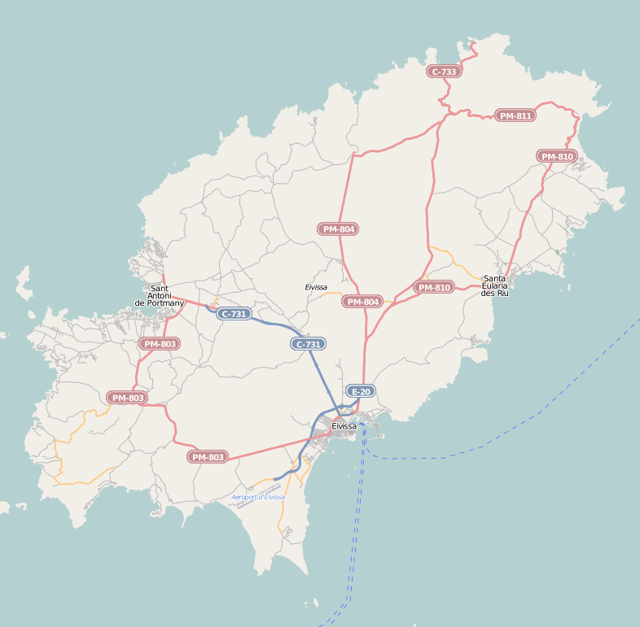
Map of roads and Ibiza Airport (on southern point) and water routes (click map to enlarge).
Ibiza is served by Ibiza Airport, which has many international flights during the summer tourist season, especially from the European Union.
Several public buses also travel between Sant Antoni and Ibiza Town—every 15 minutes in summer and every half-hour in winter.
In addition, there are buses from Sant Antoni to Cala Bassa, Cala Conta and Cala Tarida, and to the Airport.
From Ibiza there are buses to the Platja d'en Bossa, Ses Salines, the Airport, and Santa Eulària.
Cuisine
Ibiza's local cuisine is typically Mediterranean.
Of the most common culinary products of the island are sweets known as flaons. Other savory dishes include sofrit pagès, bullit de peix (fish stew), arròs de matança (rice with pork) and arròs a la marinera.

